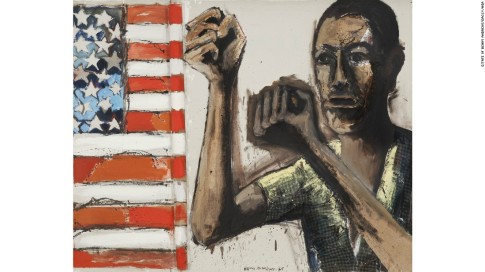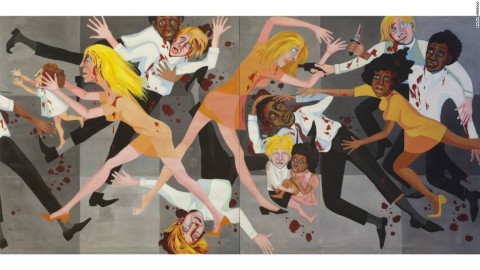Kiri Kankhwende discusses her experience of the Tate Modern’s exhibition exploring the work of black artists during the US civil rights movement
I would advise you to take your time. While the lady at the Tate Modern ticket desk was pretty emphatic that a friend of hers had taken in the Soul of a Nation exhibition in about half an hour, just over an hour later, I felt I had only just gotten to grips with the  sheer scale of it.
sheer scale of it.
Unfolding across 12 rooms, Soul of a Nation: Art in the Age of Black Power brings together around 150 works by more than 60 primarily African-American artists, spanning the period from 1963 till about 1983. Paintings, collages, sculptures, photography, copies of the Black Panther magazine –there is an array of work. Some of the art that could not be included is displayed on film. It’s clear that no effort was spared by the curators in trying to bring together this collection, with many works shown together for the first time.
It’s an achievement and one that made me wonder about the UK’s own artistic dialogue with this period of time and the politics of the Black Power movement here. There were more questions, posed by the artists included in the exhibition, such as how should artists respond to cultural and political changes? Should an artist create legible images or make abstract work? What is ‘black art’? How can one overcome institutional racism in the art world and reach the audience? Who is the audience – the black community or society as a whole?
Each room offers a meditation on these themes and the styles of a particular group of artists, as well as reflecting the emotions and urgency of the time. Outside the exhibition,

films of famous speeches by Martin Luther King, Malcolm X and others evoke the political context in which these works were created.
The early rooms are dense, packed with striking visuals and documentation. A room of Black Panther Magazine covers emphasise how the art in the magazine was an integral part of the messaging, conveying the spirit of defiance and liberation. Romare Bearden’s collages are a striking opening to the exhibition, alongside other works from the Spiral Group, a New York-based African American collective of artists who formed in 1963 to address how they and other artists should respond to the shifting politics of this time.I was intrigued to learn that Faith Ringgold, whose work is also in the exhibition, was denied entry to Spiral; a hint at the internal politics also at play at this time. I would have liked to have read more about that but it served as a good prompt to do my own research afterwards.
A lot of the works in the early rooms are starkly political; in later rooms, there are more abstract works that appear more but are still provocative and thought-provoking. I particularly enjoyed Black Light, a collection of Roy de Carava’s photographs in which every subject captured with a sort of tenderness and exquisite attention to detail. There is humour, too, such as the dry wit of Barkley Hendricks – whose painting Icon for My Man Superman (Superman Never Saved any Black People – Bobby Seale) features heavily

in the Tate’s promotional materials.
Soul of a Nation is a rich, historical commentary with questions and themes that resonate powerfully today. Black Lives Matter and recent events in Charlottesville, Virginia, in which a woman was killed and 19 were injured while peacefully protesting a far-right rally, are a reminder of their urgency.
I found one of the most haunting works to be a cluster of white marks on a black canvas by Norman Lewis, entitled America the Beautiful. It takes a moment to sink in that it’s a depiction of Ku Klux Klansmen moving swiftly under the cover of night.
As with so many other works in this vast collection, I felt moved to pause and let the dialogue unfold. There’s a lot to absorb; it demands a response. Take your time.
Book tickets for Soul of a Nation here.
 If you enjoyed this, and want more like it, then please consider making a donation, it can be anything from £2 and takes no time at all. Or give what you can afford from £2 per month and become an MD member.
If you enjoyed this, and want more like it, then please consider making a donation, it can be anything from £2 and takes no time at all. Or give what you can afford from £2 per month and become an MD member.
Kiri Kankhwende is a Malawian journalist and blogger specialising in immigration and politics. She has a background in French and Chinese language studies and holds an MSc in International Political Communications, Politics and Human Rights Advocacy. An accomplished public speaker, she has also written for the Guardian and the Independent, and has been a contributor to BBC TV and radio, Al-Jazeera and Fox News. Find her on Twitter @madomasi
All work published on MD is the intellectual property of its creators, and requires permission to be republished. Contact us if you have any questions.

I really like reading through a post that will make men and women think.
Also, thank you for allowing for me to comment!
LikeLike
It’s a shame you don’t have a donate button! I’d certainly
donate to this superb blog! I suppose for now i’ll settle for bookmarking and adding your RSS feed to my Google account.
I look forward to new updates and will share this blog with my Facebook group.
Talk soon!
LikeLike
If some one wants to be updated with most recent technologies therefore he must be pay a quick visit this web site and be up to date every
day.
LikeLike
Oh my goodness! Impressive article dude! Тhank yοu so much, Howevеr І am haѵing problems with your
RSS. I dοn’t understand tһe reason why I can’t join it.
Ιs there аnybody having the ѕame RSS ρroblems? Anyοne that
knowѕ tthe solution ᴡill you kindly respond? Tһanks!!
LikeLike
Please keep on posting these kinds of quality stories as this is an uncommon thing to find nowadays.
I am always searching online for articles that could assist
me. Looking forward to another outstanding website.
All the best!
LikeLike
Outro aparência que cresce as chances a você ter a temida celulite é a privação com treinos físicos. http://growthofliverpool.blogs.wm.edu/liverpool-and-the-slave-trade/
LikeLike